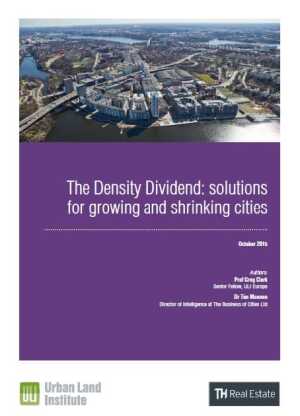Densification is the key to responding to population growth, economic changes, new lifestyle preferences, and the sustainability imperative in European cities, according to a new report by ULI and TH Real Estate.
The Density Dividend: Solutions for Growing and Shrinking Cities draws from the experience of six European cities at various stages of population change and makes clear that many cities—especially those in Europe—have little choice but to densify. If they do not, they risk becoming locked into models of development that are inflexible, unattractive, unsustainable, and ultimately uncompetitive. For cities in Europe, density is now the critical tool to realize advantages and to avoid decline.
The report is the second piece of work in ULI’s density initiative, which seeks to increase knowledge of density in the real estate industry and beyond; to address the social, economic, and environmental benefits of investing in density; and to promote density as a priority for public and private leaders.
This report examines current densification in six European cities and the impact of different urban tools and tactics on densification efforts. At the same time, it looks at how density can play a role in building strategies for future cycles.
“By embarking on this project, we wanted to use the principles for good density outlined in our first report, Density: Drivers, Dividends, and Debates, to demonstrate how cities in distinctive cycles and with different characteristics were applying them to their city development strategies,” said ULI Europe CEO Lisette van Doorn. “We hope this report develops further lessons for the industry on how density can make cities attractive to people, occupiers, and investors, today and in the future.”
“TH Real Estate advocates a city-level approach to real estate investment, believing that the most successful real estate strategy is likely to be city-based, underpinned by long-term, structural trends,” said Alice Breheny, global cohead of research at TH Real Estate. “This report helps deepen our own understanding of investment viability within specific cities. Although trends and drivers may point to a specific city as having potential for growth, it’s important to assess whether that city will be able to accommodate that growth via the capacity of its built environment to densify and absorb capital effectively.”
Authored by Greg Clark, ULI Europe senior fellow, and Tim Moonen, director of intelligence at the Business of Cities Ltd., the report highlights what does and does not work in making densification successful and popular, whether in “strongly growing,” “bounce-back,” or “consolidating” cities. It is informed by in-depth case studies of six cities: Birmingham, Dresden, Istanbul, London, Stockholm, and Warsaw.
The case studies show that cities are moving at different speeds toward better and higher density. Some have 30 years or more of experience with compact city development and urban regeneration, and are on to their second or third cycle of dense redevelopment within the framework of ambitious city plans. Others are new to urban redevelopment or lack the tools to deliver density in an integrated way, relying instead on ad-hoc initiatives and innovation.
Progress on densification can be achieved only if a city focuses on three distinct elements comprising a new equation for density. When cities get these elements of the equation synchronized, sustained progress tends to happen toward better, higher density:
• Get the fundamentals right. To increase density successfully, a city first needs leaders to develop a story and a vision for its future evolution that can galvanize the attention of and support from residents, workers, and investors alike. It must create a robust growth plan that provides a guiding framework within which development can proceed. These are fundamentals without which progress on density can be only partial and fragmented.
• Prioritize execution arrangements. To operationalize the vision of a denser city, leaders then need tactics about where and how to densify. They need to achieve a critical mass of redevelopment and promote a scale of urban adaptation that creates genuinely new dimensions to a city. They also need durable systems of investment and enhanced legal, land use, and asset management tools to shape development fully.
• Build and maintain momentum. To maintain momentum across political and economic cycles, cities also need to foster demand for new urban space and focus on the positive psychology of vibrant urban lifestyles and locations.
To read the full report, visit http://europe.uli.org/report/the-density-dividend.





